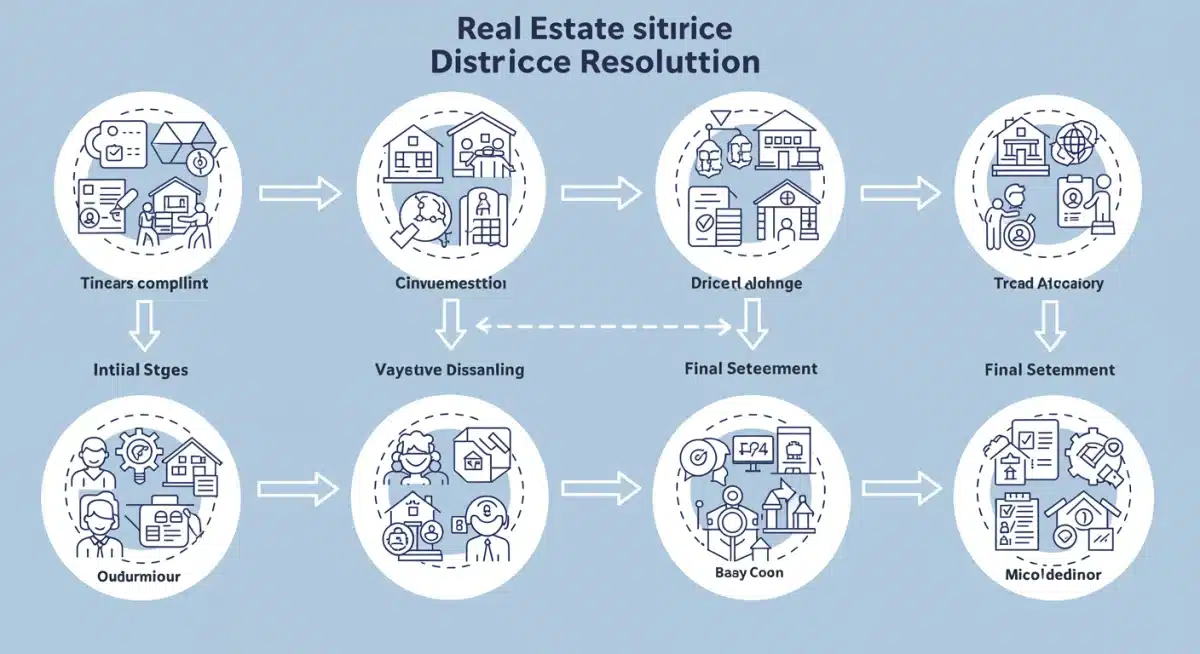Consumer Advocacy Groups: Real Estate Dispute Resolution in US

Consumer advocacy groups are pivotal in empowering individuals to navigate and resolve complex real estate disputes across the United States, providing essential resources and strategic support for effective outcomes.
Consumer Advocacy Groups: Leveraging Their Power for Real Estate Dispute Resolution in Estados Unidos is a critical topic shaping today’s real estate landscape, as individuals increasingly seek support when facing property-related challenges. This update prioritizes understanding the roles of these groups, their impact, and what consumers need to know now to protect their interests.
The Rising Importance of Consumer Advocacy in Real Estate
The real estate market in the United States, while offering numerous opportunities, also presents a complex web of transactions, contracts, and potential pitfalls. From misrepresentations by sellers to predatory lending practices and construction defects, consumers often find themselves at a significant disadvantage when disputes arise. This is where consumer advocacy groups step in, acting as a crucial counterbalance to powerful industry players.
These organizations are designed to protect the rights of consumers, providing a lifeline for those who might otherwise lack the resources, knowledge, or legal expertise to challenge unfair practices or resolve disputes effectively. Their growing influence reflects a broader societal need for accountability and transparency within the real estate sector. The landscape of real estate disputes is ever-evolving, with new challenges emerging alongside market shifts and technological advancements. Therefore, understanding how these groups operate and how to access their services is more relevant than ever for any homeowner or prospective buyer in the U.S.
Key Areas of Advocacy
- Fraud and Misrepresentation: Assisting consumers who have been victims of deceptive practices by agents, sellers, or developers.
- Contractual Disputes: Providing guidance and support in disagreements over purchase agreements, leases, or construction contracts.
- Predatory Lending: Helping individuals escape unfair loan terms and challenging illegal lending practices.
- Housing Discrimination: Fighting against discriminatory practices in housing sales, rentals, and financing.
Ultimately, consumer advocacy groups for real estate dispute resolution serve as vital intermediaries, bridging the gap between an aggrieved consumer and a fair resolution. Their work often involves not only individual case support but also systemic change through policy advocacy and public awareness campaigns, reinforcing their critical role in maintaining market integrity.
Understanding the Landscape of Real Estate Disputes
Real estate disputes can manifest in countless forms, ranging from minor disagreements over property lines to complex legal battles involving millions of dollars. The very nature of real estate—high-value assets, intricate legal frameworks, and emotional investments—makes it particularly fertile ground for conflict. These disputes often involve multiple parties, including buyers, sellers, agents, brokers, lenders, developers, and even local government entities.
The financial and emotional toll on individuals caught in such disputes can be immense. Legal fees can quickly escalate, the process can be lengthy and stressful, and the outcome often feels uncertain. This vulnerability underscores the necessity of having informed and dedicated advocates. Without proper guidance, consumers might accept unfavorable settlements or abandon their claims altogether due to perceived insurmountable obstacles.
Common Types of Real Estate Conflicts
- Boundary Disputes: Disagreements over property lines, easements, or shared access.
- Disclosure Issues: Problems arising from a seller’s failure to disclose known defects or hazardous conditions.
- Construction Defects: Disputes with builders or contractors over poor workmanship or structural problems.
- Landlord-Tenant Issues: Conflicts related to leases, security deposits, repairs, or evictions.
Effectively navigating these disputes requires not only legal knowledge but also an understanding of negotiation tactics and mediation processes. Consumer advocacy groups provide this comprehensive support, helping individuals understand their rights and the most strategic path forward to achieve a just resolution in the complex world of real estate.
How Consumer Advocacy Groups Facilitate Resolution
The primary function of consumer advocacy groups in real estate dispute resolution is to empower individuals by providing them with the necessary tools, information, and representation. Their approach is multifaceted, often beginning with consumer education and extending to mediation, negotiation, and, in some cases, direct legal intervention. These groups act as a barrier against exploitation, ensuring that consumers are not overwhelmed or outmaneuvered by better-resourced opponents.
Many groups offer free or low-cost consultations, allowing individuals to assess the viability of their claims without immediate financial burden. They can help consumers understand the nuances of real estate law, interpret complex contracts, and identify potential violations of their rights. This initial guidance is invaluable, as it sets the stage for a strategic and informed approach to resolving the dispute. Furthermore, these groups often have established networks of legal professionals, mediators, and industry experts, which they can leverage to benefit their clients.

Pathways to Resolution
- Mediation and Arbitration: Facilitating structured discussions between parties to reach a mutually agreeable settlement outside of court.
- Legal Referrals: Connecting consumers with experienced attorneys specializing in real estate law who can provide direct representation.
- Complaint Filing: Assisting in submitting formal complaints to regulatory bodies, licensing boards, or government agencies.
- Public Awareness Campaigns: Educating the wider public on common real estate pitfalls and consumer rights to prevent future disputes.
By providing these diverse services, consumer advocacy groups significantly level the playing field, making justice more accessible for individuals entangled in real estate conflicts. Their involvement can transform a daunting, complex legal challenge into a manageable process with a higher likelihood of a favorable outcome.
Choosing the Right Advocacy Group: A Strategic Decision
For consumers facing real estate disputes, selecting the appropriate advocacy group is a critical step towards achieving resolution. The landscape of these organizations is varied, with some focusing on specific types of disputes, particular demographics, or certain geographic regions. Making an informed choice requires careful research and an understanding of what each group offers, ensuring their expertise aligns with the specific needs of the consumer’s situation.
Initiating contact with several groups can provide a clearer picture of their services, track record, and approach to dispute resolution. Consumers should inquire about the group’s experience with similar cases, their success rates, and any associated costs. Transparency regarding fees, whether direct or indirect, is paramount. Many reputable organizations operate on a non-profit basis, offering services at no charge or on a sliding scale, while others might charge a nominal membership fee or request donations. It is essential to understand these financial aspects upfront to avoid any surprises.
Factors to Consider When Choosing
- Specialization: Does the group focus on the specific type of real estate dispute you are facing (e.g., landlord-tenant, construction, fraud)?
- Reputation and Track Record: Research reviews, testimonials, and public records of their past successes.
- Geographic Reach: Does the group operate in your state or region, and are they familiar with local laws and regulations?
- Services Offered: Do they provide legal advice, mediation, negotiation support, or only referrals?
Ultimately, the right consumer advocacy group will not only provide expert guidance but also instill confidence and clarity throughout the often-stressful process of real estate dispute resolution. Their support can be the determining factor in securing a favorable outcome.
Success Stories and Impact on Policy
The true power of consumer advocacy groups for real estate dispute resolution is best demonstrated through their tangible successes, both in individual cases and in broader policy changes. These groups have been instrumental in recovering millions of dollars for consumers, preventing foreclosures, and holding unscrupulous real estate professionals accountable. Each individual victory not only brings justice to the affected parties but also sends a clear message to the industry about the importance of ethical conduct.
Beyond individual cases, advocacy groups play a significant role in shaping real estate laws and regulations. They often lobby lawmakers, provide expert testimony, and conduct research to highlight systemic issues within the market. Their efforts can lead to stronger consumer protection laws, more stringent licensing requirements for real estate professionals, and greater transparency in transactions. For example, advocacy for clearer disclosure laws or protections against predatory lending has directly resulted from their sustained campaigning.

Examples of Systemic Impact
- Legislative Reform: Advocating for and influencing the passage of state and federal laws that protect consumers in real estate transactions.
- Industry Standards: Pressuring professional associations to adopt stricter codes of conduct and ethical guidelines for their members.
- Public Education: Launching campaigns that inform consumers about their rights and how to identify and avoid common real estate scams.
These collective achievements underscore the invaluable contribution of consumer advocacy groups. Their work not only resolves current disputes but also proactively works to prevent future ones, fostering a more equitable and trustworthy real estate environment for everyone in the United States.
Challenges and Future Directions for Advocacy
Despite their successes, consumer advocacy groups for real estate dispute resolution face ongoing challenges that impact their effectiveness and reach. Funding limitations, the sheer complexity of real estate law, and the constant evolution of market practices are significant hurdles. Many of these organizations rely heavily on grants, donations, and volunteer efforts, which can fluctuate and limit their capacity to serve all who need assistance. The legal landscape itself is dynamic, requiring continuous adaptation and expertise to address new forms of real estate fraud or emerging market trends.
Looking ahead, the future of consumer real estate advocacy will likely involve a greater emphasis on technological integration and collaborative efforts. Utilizing digital platforms for outreach, education, and even dispute resolution could significantly expand their reach. Furthermore, fostering stronger partnerships with government agencies, legal aid societies, and academic institutions can create a more robust support system for consumers. The goal remains to create a more transparent, fair, and accessible real estate market for all, continuously adapting to new challenges and opportunities.
Emerging Trends in Advocacy
- Digital Platforms: Leveraging online tools for dispute resolution, virtual consultations, and resource dissemination.
- Data Analytics: Using data to identify patterns of fraud and systemic issues, informing targeted advocacy efforts.
- Cross-Jurisdictional Collaboration: Forming alliances with groups in different states to address issues that span multiple regions.
The continued relevance and impact of consumer advocacy groups will depend on their ability to innovate, secure stable funding, and effectively adapt to the ever-changing dynamics of the U.S. real estate market. Their persistent efforts are crucial for ensuring that consumer rights remain at the forefront of policy and practice.
| Key Aspect | Brief Description |
|---|---|
| Empowerment | Advocacy groups provide essential resources, knowledge, and support to individuals navigating complex real estate disputes. |
| Dispute Types | They address issues from fraud and misrepresentation to construction defects and predatory lending practices. |
| Resolution Methods | Facilitate mediation, offer legal referrals, assist with complaint filing, and contribute to policy changes. |
| Future Outlook | Focus on technological integration, data analytics, and collaborations to enhance reach and effectiveness. |
Frequently Asked Questions About Real Estate Advocacy
Their primary role is to protect consumers’ rights by providing information, resources, and support to resolve issues like fraud, misrepresentation, and contractual disagreements. They also work to educate the public and advocate for policy changes to improve market fairness.
Advocacy groups can guide victims through the process of gathering evidence, understanding legal options, and filing formal complaints. They may also connect individuals with specialized attorneys or assist in negotiations to recover losses and seek justice against fraudulent parties.
While many operate on a non-profit basis and offer free or low-cost services, it varies by organization. Some may request donations, charge a nominal membership fee, or offer services on a sliding scale. It’s crucial to clarify any potential costs upfront.
They handle a wide range, including disputes over property disclosure, construction defects, predatory lending, landlord-tenant issues, and unfair contracts. Their scope often extends to any scenario where a consumer’s rights in a real estate transaction may have been violated.
Advocacy groups actively lobby lawmakers, provide expert testimony, and conduct research to highlight systemic problems. Their efforts frequently lead to the creation of new consumer protection laws, stricter industry regulations, and greater transparency in real estate transactions, benefiting all consumers.
Outlook and Implications – Strengthening Consumer Protection in Real Estate
The growing prominence of consumer real estate advocacy across the United States underscores a fundamental shift in how fairness, transparency, and accountability are being woven into the property market’s future. As housing transactions become more digitized and financial structures increasingly complex, the role of advocacy organizations is evolving from reactive support to proactive market oversight, ensuring that both buyers and sellers operate within frameworks rooted in ethical standards and consumer safety.
These advocacy efforts serve not only to protect individuals from predatory lending, misinformation, or exploitative contracts but also to educate communities on their legal rights, credit options, and dispute resolution mechanisms. Resources provided by dedicated groups such as Consumer Advocates exemplify this mission—offering vital guidance, research, and legal insights that empower Americans to make informed housing decisions. Their continued work reinforces the balance between private enterprise and public interest, making real estate more transparent and accountable for all participants.
Looking ahead, the impact of these organizations will expand as they collaborate with policymakers, regulators, and local housing authorities to craft reforms that enhance affordability, strengthen anti-discrimination measures, and establish clearer consumer redress pathways. In this next phase, informed participation will be key: homeowners, tenants, and investors alike must recognize advocacy as an ally in safeguarding long-term housing stability.
Ultimately, the path toward a more equitable real estate landscape will rely on active consumer engagement, policy innovation, and the persistent commitment of advocacy groups ensuring that every transaction—whether renting, buying, or investing—reflects both economic fairness and social responsibility.





